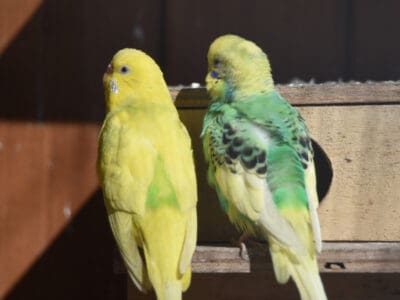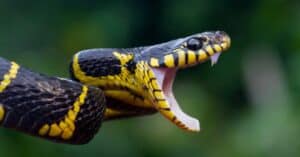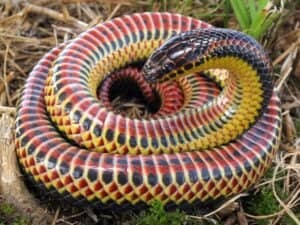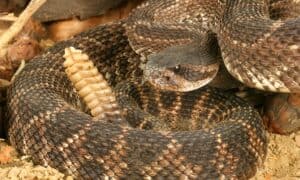Discover 8 Animals Invading Florida!
@media (min-width: 481px) {
.mobile-top-content {
display: none;
}
}
#mobileTopContentCTACarouselControls { overflow: hidden; text-overflow: ellipsis; white-space: nowrap; }
.mobile-top-content .more { color: #fff; }
.mobile-top-content a { color: #fff; text-decoration: underline; }
.mobile-top-content a:hover { color: #fff; text-decoration: underline; }
@media (max-width: 480px) {
.mobile-top-content {
background-color: #06a10b;
color: #fff;
text-align: center;
/*height: 60px;
padding-top:5px;*/
font-size:80%;
/* display: block; */
margin: 0px -30px;
}
}
Is that an alligator swimming through the Everglades? No, it is a giant snake! Burmese Pythons are invading Florida. They have moved into the Everglades Park area and are wreaking havoc on the other species that call the Everglades their home. What other non-native animals are invading Florida? Are there 8-inch poisonous toads? What about the largest rodent in the world? Let’s discover 8 animals invading Florida!
1) Burmese Pythons
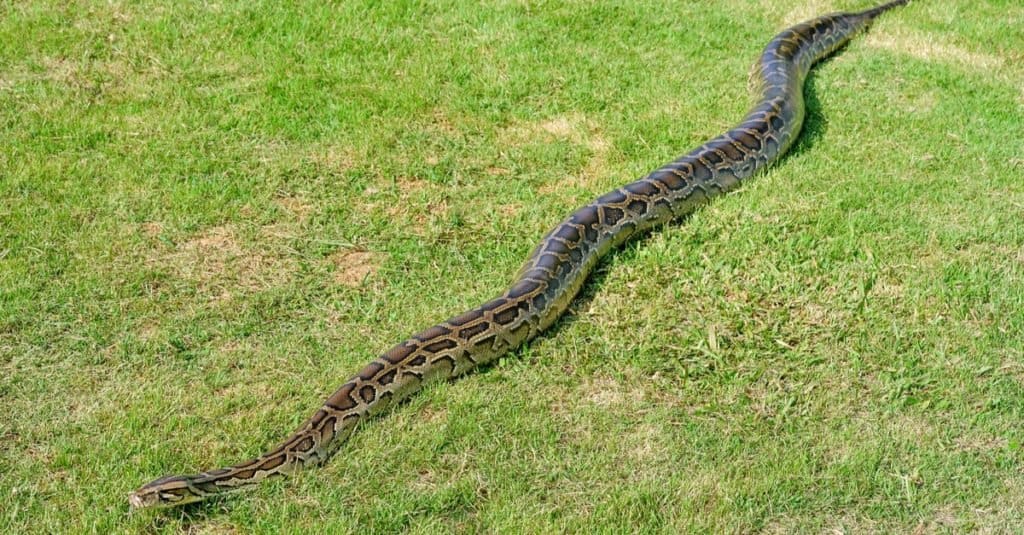
Yatra/Shutterstock.com
Burmese Pythons are enormous snakes! They can grow to be 20 feet long and are heavy, some getting to be 200 pounds. You may have seen a picture of 4-5 grown adults holding the length of a python. They are not native to Florida or the United States, living in the jungles and marshes of Asia, including India, China and Vietnam. The first one was recorded in the Everglades National Park in October of 1979, since then they have been growing in numbers and by the year 2000 they had enough to be considered a breeding population. They are a huge problem (play on words intended) because they kill and eat many of the native animals, some of which are endangered.
Researchers have documented that the rabbit population in the Everglades is gone. Raccoons, opossum and bobcat sightings have decreased significantly (99% less for raccoon and opossum and 88% less for bobcats. Small endangered species like the mangrove fox squirrel and the wood stork are killed and eaten by the pythons. Work continues to try to stop their progression.
2) Wild Boars (Feral Hogs)
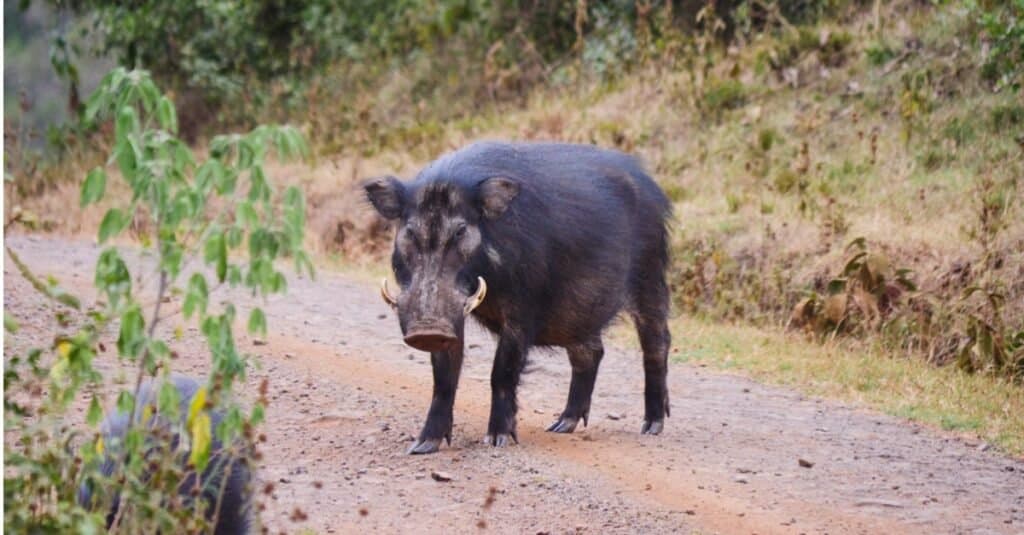
iStock.com/chingkai huang
Wild Boars are found in most states in the US but it wasn’t always that way. They were brought over from Spain in the Early 1600’s as livestock but a group of them escaped and it wasn’t long before breeding populations were popping up all over. These boars are big! Some can get to be 400 pounds and they are aggressive. As large animals invading Florida, they are wrecking the plants and ground cover by rooting up massive areas of land. A herd of hogs can ruin acres of crops in just hours. Wild boars can be hunted and this helps with controlling their spread, but they are extremely difficult to get rid of altogether.
3) Fire Ants
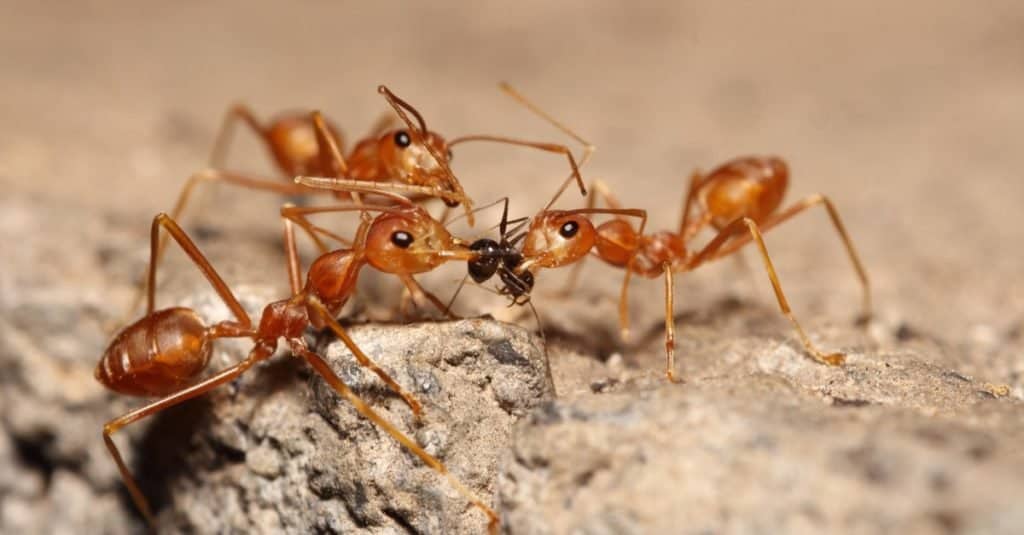
sarawuth wannasathit/Shutterstock.com
You would not want to slide off your flip-flops and accidentally step on a fire ant hill. When they are disturbed they immediately react by biting and running upwards. If it is your foot they find they will run up your leg leaving painful bite marks along the way. And they react in large groups. Their bites are not fatal but do leave sore, itching bites that can last up to ten days. Each colony has a mix of red ants with some being as small as 1/16 inch and others large at 1/4 inch. Fire Ants are originally from South America and were thought to come into the US in the 1930’s through the port in Mobile, Alabama, probably in the ballasts of a ship.
4) Cane Toads

Peter Yeeles/Shutterstock.com
It may be disappointing to wake up to see a yard full of dandelions, but what if you found a yard full of giant 8-inch toads! Cane toads, also called Bufo toads, are typically 4-6 inches but some can get up to 9 inches. They are grayish-brown and covered in warts. The biggest problem is they excrete a milky white toxin through their skin. Pets and small children are at risk from becoming very sick if they touch or ingest the toxin. Dogs or cats that sniff around a toad or try to eat one can die within 15 minutes if not treated immediately. Small children can suffer a painful rash if they touch one of the toads. They are found in south and central Florida and parts of the panhandle.
5) Iguanas
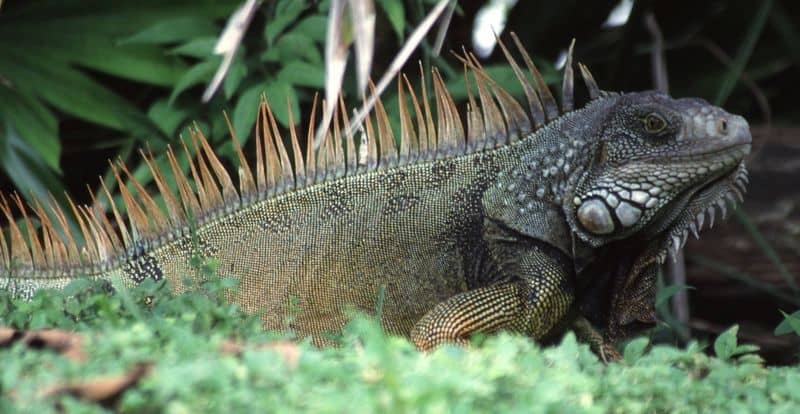
If there aren’t giant toads in your yard, maybe there is a five-foot iguana! Green Iguanas became one of the animals invading Florida in the 1960’s, when they were first recorded in the region. They can be green, brown a tinge of orange or black. Their backs are lined with spikes and they are excellent swimmers. There are two main problems with these invading Florida. First they burrow large tunnels that wreck foundations of residential and commercial property. Imagine the size of a burrow of a five-foot long lizard! Secondly, they are incredibly messy leaving their feces all over and the feces can transmit salmonella which can make humans very sick. If you want to get rid of one you can call a professional nuisance wildlife trapper and they will take care of it.
6) Lionfish
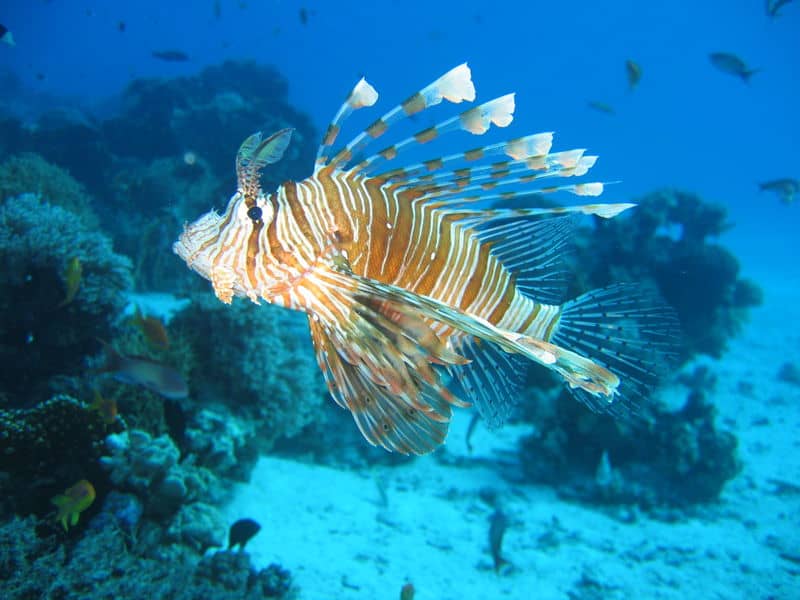
Tobias Biehl – Public Domain
Lionfish are spectacular looking but they eat all kinds of native fish! They are disturbing the balance of small fish around coral reefs off the coasts of Florida. Because they have venomous spines, there are very few larger fish or predators that will kill them so they can take over. Lionfish are large; around 18 inches long, and have brown/maroon stripes. Back to the venomous spines, they are harmful to humans as well and if you are stung by the spines you should seek immediate medical attention. These were first seen in Florida waters in 1985, but they are originally from South Pacific and Indian Oceans. They are now all along the eastern coast of the US all the way up to New York.
7) Zebra Mussels
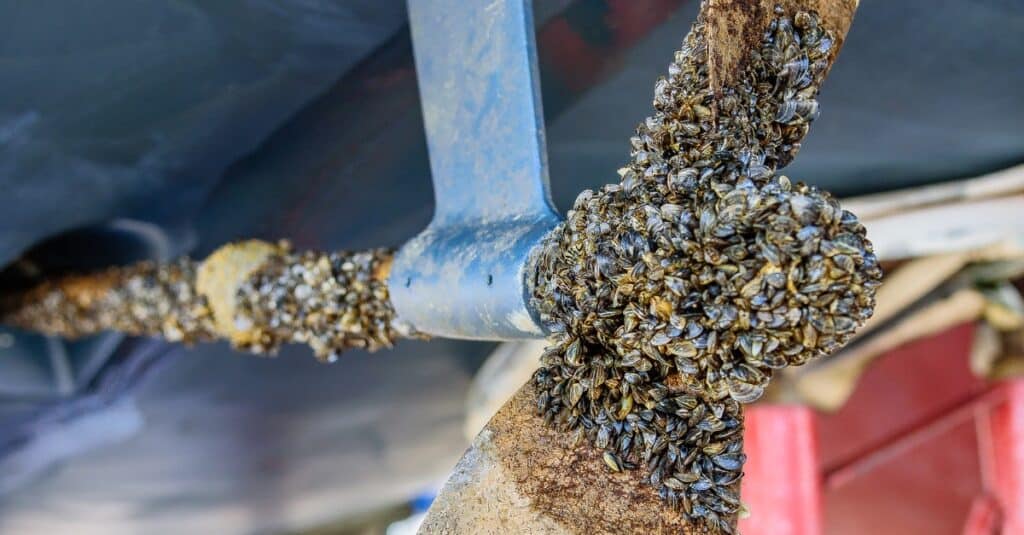
iStock.com/JeffCaughey
Although zebra mussels are small, with the larvae invisible to the naked eye, these small shellfish team up to cause a lot of trouble as adults. They live in shells that are striped, brown and white and can get to be around ¼ to 1 inch long. The most recent problem is in March of 2021, authorities were alerted to zebra mussels being imported in “moss balls” that are used in people’s aquariums. The problem with zebra mussels is they attach to hard surfaces and line the inside of water pipes, clogging them. They are also very harmful to the rivers and lakes they live in eating all the plankton and zoo plankton and leaving the water acidic.
8) Capybara

Horus2017/Shutterstock.com
With the title, “The World’s Largest Rodent”, you already know these guys are trouble. Capybaras are 4 feet long! They weigh between 75- 145 pounds and usually live in groups of around 10. As a semi-aquatic animal you can see how they would love to make Florida their home. Although counted as animals invading Florida, luckily there is not a breeding population of Capybaras in Florida yet. There are sightings throughout the state and Gainesville is an area of concern. The problem with these rodents is similar to wild boars, a group of them can raid gardens and destroy vegetation. They also may carry disease that can spread to livestock. Capybaras are native to South America and it is unclear how they first entered Florida. Hopefully we can keep them in-check so they do not spread throughout the southeast!
More from A-Z Animals
.more-snake-card-image { max-height:140px !important; }
@media (min-width: 481px) {
.mobile-top-content {
display: none;
}
}
#mobileTopContentCTACarouselControls { overflow: hidden; text-overflow: ellipsis; white-space: nowrap; }
.mobile-top-content .more { color: #fff; }
.mobile-top-content a { color: #fff; text-decoration: underline; }
.mobile-top-content a:hover { color: #fff; text-decoration: underline; }
@media (max-width: 480px) {
.mobile-top-content {
background-color: #06a10b;
color: #fff;
text-align: center;
/*height: 60px;
padding-top:5px;*/
font-size:80%;
/* display: block; */
margin: 0px -30px;
}
}
Is that an alligator swimming through the Everglades? No, it is a giant snake! Burmese Pythons are invading Florida. They have moved into the Everglades Park area and are wreaking havoc on the other species that call the Everglades their home. What other non-native animals are invading Florida? Are there 8-inch poisonous toads? What about the largest rodent in the world? Let’s discover 8 animals invading Florida!
1) Burmese Pythons

Yatra/Shutterstock.com
Burmese Pythons are enormous snakes! They can grow to be 20 feet long and are heavy, some getting to be 200 pounds. You may have seen a picture of 4-5 grown adults holding the length of a python. They are not native to Florida or the United States, living in the jungles and marshes of Asia, including India, China and Vietnam. The first one was recorded in the Everglades National Park in October of 1979, since then they have been growing in numbers and by the year 2000 they had enough to be considered a breeding population. They are a huge problem (play on words intended) because they kill and eat many of the native animals, some of which are endangered.
Researchers have documented that the rabbit population in the Everglades is gone. Raccoons, opossum and bobcat sightings have decreased significantly (99% less for raccoon and opossum and 88% less for bobcats. Small endangered species like the mangrove fox squirrel and the wood stork are killed and eaten by the pythons. Work continues to try to stop their progression.
2) Wild Boars (Feral Hogs)

iStock.com/chingkai huang
Wild Boars are found in most states in the US but it wasn’t always that way. They were brought over from Spain in the Early 1600’s as livestock but a group of them escaped and it wasn’t long before breeding populations were popping up all over. These boars are big! Some can get to be 400 pounds and they are aggressive. As large animals invading Florida, they are wrecking the plants and ground cover by rooting up massive areas of land. A herd of hogs can ruin acres of crops in just hours. Wild boars can be hunted and this helps with controlling their spread, but they are extremely difficult to get rid of altogether.
3) Fire Ants

sarawuth wannasathit/Shutterstock.com
You would not want to slide off your flip-flops and accidentally step on a fire ant hill. When they are disturbed they immediately react by biting and running upwards. If it is your foot they find they will run up your leg leaving painful bite marks along the way. And they react in large groups. Their bites are not fatal but do leave sore, itching bites that can last up to ten days. Each colony has a mix of red ants with some being as small as 1/16 inch and others large at 1/4 inch. Fire Ants are originally from South America and were thought to come into the US in the 1930’s through the port in Mobile, Alabama, probably in the ballasts of a ship.
4) Cane Toads

Peter Yeeles/Shutterstock.com
It may be disappointing to wake up to see a yard full of dandelions, but what if you found a yard full of giant 8-inch toads! Cane toads, also called Bufo toads, are typically 4-6 inches but some can get up to 9 inches. They are grayish-brown and covered in warts. The biggest problem is they excrete a milky white toxin through their skin. Pets and small children are at risk from becoming very sick if they touch or ingest the toxin. Dogs or cats that sniff around a toad or try to eat one can die within 15 minutes if not treated immediately. Small children can suffer a painful rash if they touch one of the toads. They are found in south and central Florida and parts of the panhandle.
5) Iguanas

If there aren’t giant toads in your yard, maybe there is a five-foot iguana! Green Iguanas became one of the animals invading Florida in the 1960’s, when they were first recorded in the region. They can be green, brown a tinge of orange or black. Their backs are lined with spikes and they are excellent swimmers. There are two main problems with these invading Florida. First they burrow large tunnels that wreck foundations of residential and commercial property. Imagine the size of a burrow of a five-foot long lizard! Secondly, they are incredibly messy leaving their feces all over and the feces can transmit salmonella which can make humans very sick. If you want to get rid of one you can call a professional nuisance wildlife trapper and they will take care of it.
6) Lionfish

Tobias Biehl – Public Domain
Lionfish are spectacular looking but they eat all kinds of native fish! They are disturbing the balance of small fish around coral reefs off the coasts of Florida. Because they have venomous spines, there are very few larger fish or predators that will kill them so they can take over. Lionfish are large; around 18 inches long, and have brown/maroon stripes. Back to the venomous spines, they are harmful to humans as well and if you are stung by the spines you should seek immediate medical attention. These were first seen in Florida waters in 1985, but they are originally from South Pacific and Indian Oceans. They are now all along the eastern coast of the US all the way up to New York.
7) Zebra Mussels

iStock.com/JeffCaughey
Although zebra mussels are small, with the larvae invisible to the naked eye, these small shellfish team up to cause a lot of trouble as adults. They live in shells that are striped, brown and white and can get to be around ¼ to 1 inch long. The most recent problem is in March of 2021, authorities were alerted to zebra mussels being imported in “moss balls” that are used in people’s aquariums. The problem with zebra mussels is they attach to hard surfaces and line the inside of water pipes, clogging them. They are also very harmful to the rivers and lakes they live in eating all the plankton and zoo plankton and leaving the water acidic.
8) Capybara

Horus2017/Shutterstock.com
With the title, “The World’s Largest Rodent”, you already know these guys are trouble. Capybaras are 4 feet long! They weigh between 75- 145 pounds and usually live in groups of around 10. As a semi-aquatic animal you can see how they would love to make Florida their home. Although counted as animals invading Florida, luckily there is not a breeding population of Capybaras in Florida yet. There are sightings throughout the state and Gainesville is an area of concern. The problem with these rodents is similar to wild boars, a group of them can raid gardens and destroy vegetation. They also may carry disease that can spread to livestock. Capybaras are native to South America and it is unclear how they first entered Florida. Hopefully we can keep them in-check so they do not spread throughout the southeast!



